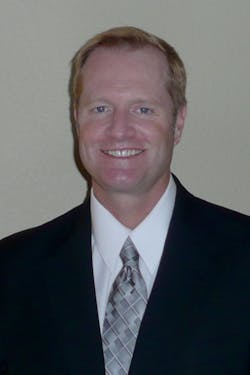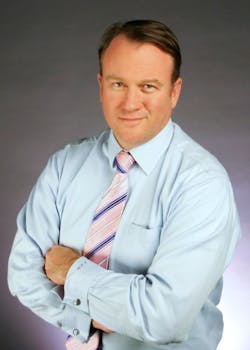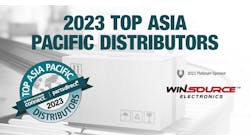Download the list of Top 50 Distributors 2013
The largest distributors of electronic components in North America aren’t expecting blockbuster growth this year, but they do anticipate a slow and steady upturn in business by the time 2013 is over. Following a 2012 in which many companies focused on internal investment and development, this year is turning out to be one of incremental growth and gaining market share, with most companies predicting mid-single-digit increases for the year.
“I think distributors spent 2012 working on their inventories, on their productivity, on their efficiencies,” says Faris Aruri, vice president of corporate marketing for Sager Electronics, number 11 on the 2013 Top 50 Distributors report. “Margin continues to be a challenge and I believe that companies devoted the bulk of the year addressing their structure, their strategy.”
“I think this year is almost as difficult for predictions as last year,” adds Jimmy Seifert, senior vice president at Newark element14, number six on this year’s list. “Growth estimates are in the single digits, heavily leaned on the back half of the year.”
As they battle the sluggish conditions here at home, electronics distributors are also sharpening their focus on the Internet, watching the global economy closely and trying to keep their fingers on the pulse of an increasingly active regulatory environment that has customers placing new demands on them almost daily. These regulations have come to a head in the last year as the federal government has clamped down on contractors supplying electronic equipment to the armed services in an effort to curtail the flow of counterfeit parts into the defense supply chain. Government contractors have naturally turned to their component suppliers for additional levels of quality assurance.
Despite these challenges, the top distributors are optimistic about the electronics industry’s long-term outlook, helped largely by the growing amount of electronics in all aspects of daily life. The proliferation of smart phones and other handheld gadgets combined with the ever-increasing “smartness” of everything from refrigerators to cars and trucks makes the electronics supply chain a good place to be, they say.
Executive Interviews
- 5 Questions With: Ed Smith, President, Avnet Electronics Marketing
- Q&A with Future Electronics’ Lindsley
- 5 Questions with Glenn Smith, Mouser Electronics
- Top 10 Electronics Distributors 2013
- Globalization, product obsolescence top supply chain challenges
- Top 50 Electronics Distributors 2012
Game Changer: The Internet
When asked about the greatest change in the industry since last year’s Top 50 report, TTI’s Michael Knight doesn’t hesitate when he says: “the Internet factor.” Though electronics distributors have been steadily increasing their online investments and development for the last several years, Knight says 2012 stands out as a year of heightened investment and growing struggles about how to best integrate the technology into the electronics distribution model. The Internet’s presence as a leveler and at the same time a disruption makes it a force difficult to manage, he adds.
“Last year, it seemed the Internet factor became more prevalent and more obvious,” explains Knight, senior vice president, Americas for TTI, number four in this year’s report. He points to new competition from non-traditional sources and distributors’ pursuit of new ways to best serve customers online as key examples. He also points to pricing as a key challenge in the Internet age. A lack of Internet resale pricing guidelines is a particular sticking point, and one the industry will eventually have to confront.
“The Internet is the place where people go to shop,” Knight explains. “I do think it’s a growing challenge for distributors and OEMs [original equipment manufacturers], and we really need to give some thought to Internet pricing. Otherwise, we run the risk of creating a leak where there’s just a tremendous amount of margin that can be sucked out of our business.”
Newark element14’s Seifert agrees that the Internet is an industry game-changer, most notably for its value as a research and information tool. As more and more engineers, hobbyists, and procurement professionals search for products online, distributors must be at the ready not only with product and pricing information, but with the resources, tools, and technical support customers need to do their jobs, he explains.
“Just as the trend has exploded in the consumer world, it’s becoming more prevalent in ours as well,” Seifert says. Challenges aside, he notes that the trend fits well with the electronics distributor’s role as a provider of information and solutions.
“It really bodes well with how we go to market to support customer needs,” says Seifert, pointing to Newark’s element14 online community in particular, which functions as a professional social media outlet for engineers, offering product information, technical support, and online forums where they can connect with peers.
Knight agrees that the collaborative spirit of the Internet offers a key opportunity for distributors to harness the technology’s power.
“How best to integrate the Internet into our business, which is a more traditional model of people on people, that’s the question,” says Knight. “[We need to address] how best to integrate the Internet element in a way that’s good for our customers, good for our suppliers, and truly additive to our business.”
Struggle: The Economy
For many distributors, 2013 has been a year of pleasant surprises thus far. Most entered the year expecting little by way of growth and were surprised by better than anticipated bookings in the first quarter. Although few will point to the quarter as a harbinger of what’s to come, most of the Top 50 remain cautiously optimistic about the industry outlook given the tough global economic climate they’re struggling against.
“I can’t see anybody being unhappy with the first quarter. I think it was much better than expected. But these are good short-term trends. I’m unsure they’ll hold for the year,” says Sager’s Aruri. “The economic backdrop has improved marginally. It’s in an area you’d term stable versus robust. But even in this atmosphere there’s an opportunity to pick up market share for those who really achieved something internally over the last year.”
Lindsley Ruth, executive vice president for Future Electronics, number three on this year’s list, agrees. He says 2012 was an investment year for Future and that the company is already seeing the benefits of that internal focus this year.
“At Future, we’re very optimistic about this year. Last year was a year of investment, and we’re beginning to reap the benefits of that investment,” Ruth explains, noting investments in new salespeople, inventory, and customer-focused programs around supply chain management and e-commerce. “We’re seeing an uptick in demand, so we’re gaining confidence as we go. We’re looking at a year in the supply chain that will be up in the high single digits to low double-digits.”
Ruth points to customer-relationship management as another key investment area for Future Electronics. Salespeople are trained to focus on building relationships and streamlining operations throughout the channel, for instance.
“We like to move from a pure transactional relationship with the customer to more of a true partnership [in which we] share resources and help the customer increase their business,” Ruth explains. “If we can help the customer with their customer, we’re adding more value than the competition.”
Looking at particular markets, many of the Top 50 say they anticipate continued growth in the automotive industry, resurgence in the medical markets, and growth in the aerospace segment, particularly commercial avionics. This will be offset by a downturn in military and defense, according to some. Smaller niche market distributors such as Sager are capitalizing on the trends.
“Sager focuses on the industrial, medical, and instrumentation markets,” says Aruri. “All of these markets have been either stable or growing and I’m confident in our ability to pick up market share in this environment.”
For larger players such as Avnet, who cast a wider net, the outlook is a bit more complex. Ed Smith, Americas president for Avnet Electronics Marketing, characterizes 2013 as steady and “not very exciting.” Despite the tough market conditions Avnet remains number one on SourceESB’s Top 50 for the third straight year. Smith points to strength in automotive and aerospace industries and slowing conditions in military/defense markets this year.
“When I look at the industrials, I think they’re still pretty flat and not very exciting—and in the Americas, we’re driven by that,” Smith says. “So, [conditions] are not very exciting, but there are some glimmers of hope in automotive and aerospace.”
Regionally, Avnet has seen growth in Mexico as customers begin to move manufacturing business from Asia back to the Americas, Smith adds. The re-shoring trend has been the topic of much industry buzz in the last year, and many say it’s unfolding more slowly than they’d hoped. Large independent distributor N.F. Smith & Associates, number 10 on this year’s list, expanded its operations in Guadalajara, Mexico, last year to accommodate increased business among its manufacturing customers in the region, for example. Company COO Matt Hartzell points to rising wages and housing costs in China in particular as a key reason some manufacturers are beginning to move or consider moving some manufacturing operations back toward North and Central America.
“You might see a continuation of that if labor and real estate prices continue to climb in China,” he says.
For others, re-shoring is still a distant trend they hope is soon realized. TTI’s Knight says the issue is still more talk than reality among his customers, but adds that he thinks such opportunities will eventually materialize.
“I am watching out for it like a hawk,” Knight says. “I’m reading a lot about it. In our own business we’re aware of some customers who are talking about doing it, but I can’t say I can actually yet put my finger on a piece of business that is booking and shipping in North America that yesterday was booking and shipping in Asia or somewhere else. But I do have reason to believe it is coming. And that has good long-term implications for our economy and our industry.”
New Wrinkle: Regulatory Issues
Counterfeit components and the need for quality assurance is a growing concern among the Top 50 distributors. The issue transcends the authorized/independent line as customers seek quality assurance documentation on a range of levels from all their trading partners, placing new pressure and more work on distributors of all shapes and sizes.
The issue has been building since the late 2011 passage of the National Defense Authorization Act, which includes new rules and regulations around counterfeit electronic parts found in the defense supply chain. The NDAA includes, or directs government agencies to include, new rules for defense contractors and impose steep penalties on those who supply counterfeit components to the military. As a result, contractors are seeking new assurances from their suppliers that the parts they are purchasing are authentic.
The issue has shined a light on the independent distribution market, and distributors such as N.F. Smith & Associates say they have seen a consolidation in that market that may signify a turning point for the industry. The heightened focus on quality is raising the bar among independents, and those that don’t offer testing and other vital quality assurances simply aren’t making the grade.
“We’ve seen a lot of consolidating among the independents and the cream has kind of risen,” says Marc Barnhill, chief trading officer for N.F. Smith. “There aren’t as many as there used to be, and we think that’s a trend that will continue.”
| View The Top 50 Distributors 2015 Now |
The heightened focus on counterfeits is also affecting the authorized distribution channel. Authorized distributors purchase products directly from the manufacturer or other authorized distributors, in essence ensuring authenticity. But many large distributors are finding that some customers don’t understand the authorized model and are placing new demands on those distributors as well, most notably seeking certificates of compliance with every order. As a result, a group of authorized distributors is working through the industry’s G19 Committee—an SAE International group that works to address prevention, detection, and electronics industry response to the counterfeit threat—to define authorized distribution.
Pete Shopp, senior vice president, business operations for Mouser Electronics, number 8, points to customers’ growing demand for traceability, noting that some customers are demanding access to manufacturer packing slips to ensure authenticity, for example.
“It’s all centered around making sure they have genuine parts, and that’s understandable given the emphasis by the Department of Defense,” says Shopp. “We’re involved with several industry groups promoting authorized distribution and what that means. We even have someone working with the G19 committee trying to come up with a definition of authorized distribution.”
The issue concerns Sager’s Aruri, as well, particularly because it’s beginning to spill over to non-defense industries.
“The need for [certificates of compliance] has crossed from the military world to the commercial world,” says Aruri. “Customers have a need to cover themselves in this area, so they’re starting to require [certificates of compliance] with every order. Distribution is not set up to do this. We all have traceability if we’re requested to go back, but it’s very challenging to do it [up front].”
Aruri says Sager is likewise involved in industry efforts to explain and promote the authorized channel.
“We’re participating in any initiative that encourages people to buy from authorized distributors,” he says.
Outlook: More Electronics, More Business
Despite the challenges ahead, SourceESB’s Top 50 Electronics Distributors say the long-term outlook is bright for the electronics supply chain. Avnet’s Smith points to the growing amount of electronics in the automotive industry as a shining example, and he also notes that increasing demand for electronics in areas of limited growth, such as defense, are good reason for a positive view. Others agree, pointing to the proliferation of electronics in industrial applications, consumer markets, and more.
“Certainly, one of the reasons to be enthusiastic about being in the technology industry is the expansion of these [components] to other industries. Industrial applications, oil and gas, automotive—every month, every year these components get put into equipment that they weren’t in the year before. Just look at the technology in your refrigerator,” says N.F. Smith & Associates’ Hartzell. “We are poised to always stay on top of wherever that market expands.”
Download the list of Top 50 Distributors 2013
The Methodology Behind Our Survey
The Source ESB staff and Penton Media’s research department began our 2013 Top 50 Distributors survey in February, contacting hundreds of North American electronics distributor locations via e-mail and on GlobalPurchasing.com. Throughout February and March, the staff narrowed the online submission forms to 50, ranking each company based on total sales volume and ensuring that each had a major presence in the North American electronic components distribution market.
Each company in the list is ranked according to its total global sales volume, and all figures are reported in U.S. dollars. We used self-reported data from each company and verified the information against annual reports and earnings statements, where possible, as well as in follow-up interviews with some of the companies at the top of the list. Yet there’s more than meets the eye with some of the companies at the top of our list.
Figures for Avnet Inc., ranked number one, and Arrow Electronics, ranked number two, include the sale of computer products, which comprise large segments of each company’s business. Other companies in the list also sell computer products along with electrical products and equipment. As a result, figures in the “active” and “I/P/E” categories may not add to 100% for each top-ranked distributor.
Sales listed for privately held Future Electronics, number three, are based on Source ESB estimates.
Figures for Allied Electronics, number four, reflect its worldwide sales as part of Britain-based Electrocomponents plc, which also operates RS Components in Europe. The figure here is a company-provided, fiscal-year estimate for global sales. Allied’s sales were roughly $420 million in 2012. Likewise, sales for number six, Newark element14, reflect worldwide sales as part of its parent company, Britain-based Premier Farnell.
Our goal is to provide a comprehensive list of the largest electronic components distributors doing business in North America. We will begin compiling information for next year’s report early in 2014.
We welcome your input as we develop next year’s report. Send your questions or comments to [email protected].
The Top 50 Electronics Distributors 2013:
1. AVNET INC.
2. ARROW ELECTRONICS
3. FUTURE ELECTRONICS
4. TTI INC.
5. ALLIED ELECTRONICS INC.
6. NEWARK ELEMENT14
7. DIGI-KEY CORP.
8. MOUSER ELECTRONICS
9. DAC / HEILIND ELECTRONICS
10. N.F. SMITH & ASSOCIATES
11. SAGER ELECTRONICS
12. PEI_GENESIS
13. AMERICA II ELECTRONICS
14. MASETER ELECTRONICS
15. POWELL ELECTRONICS INC.
16. BISCO INDUSTRIES INC.
17. RAND TECHNOLOGY INC.
18. FLAME ENTERPRISES
19. ELECTRO ENTERPRISES INC.
20. ELECTRO SONIC INC.
21. BEYOND COMPONENTS / NEDCO
22. HUGHES-PETERS
23. EDGE ELECTRONICS, INC.
24. STEVEN ENGINEERING
25. SYMMETRY ELECTRONICS
26. CPN / DENELEX GROUP
27. IBS ELECTRONICS INC.
28. ASTREX ELECTRONICS INC.
29. HAMMOND ELECTRONICS
30. COMMODITY COMPONENTS INTERNATIONAL INC.
31. DEE ELECTRONICS INC.
32. AIR ELECTRO INC.
33. PUI (PROJECTIONS UNLIMTINED INC.)
34. SMD INC.
35. CRESTWOOD TECHNOLOGY GROUP (CTG)
36. HOUSE OF BATTERIES
37. PHOENICS ELECTRONICS CORPORATION
38. MARCH ELECTRONICS
39. KENGINGTON ELECTRONICS INC.
40. COMPONENT TRENDS
41. 4 STAR ELECTRONICS INC.
42. CUMBERLAND ELECTRONICS STRATEGIC SUPPLY SOLUTIONS
43. AREA51-ESG INC.
44. COMPONENTS CENTER
45. IXES USA
46. VIRGINIA ELECTRONIC COMPONENTS (VEC LLC)
47. ADVANTAGE ELECTRIC SUPPLY
48. EAST COAST MICROWAVE DISTRIBUTORS
49. MARINE AIR SUPPLY
50. INDUCTORS INC.











